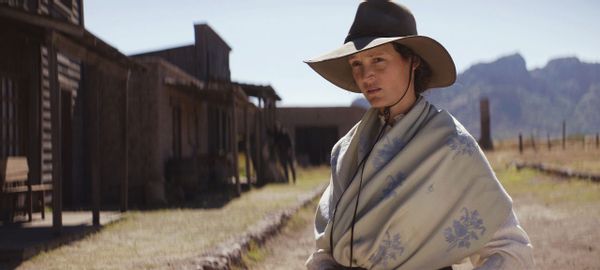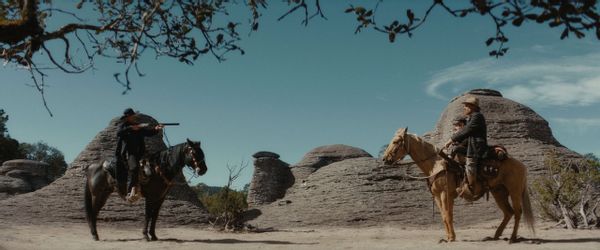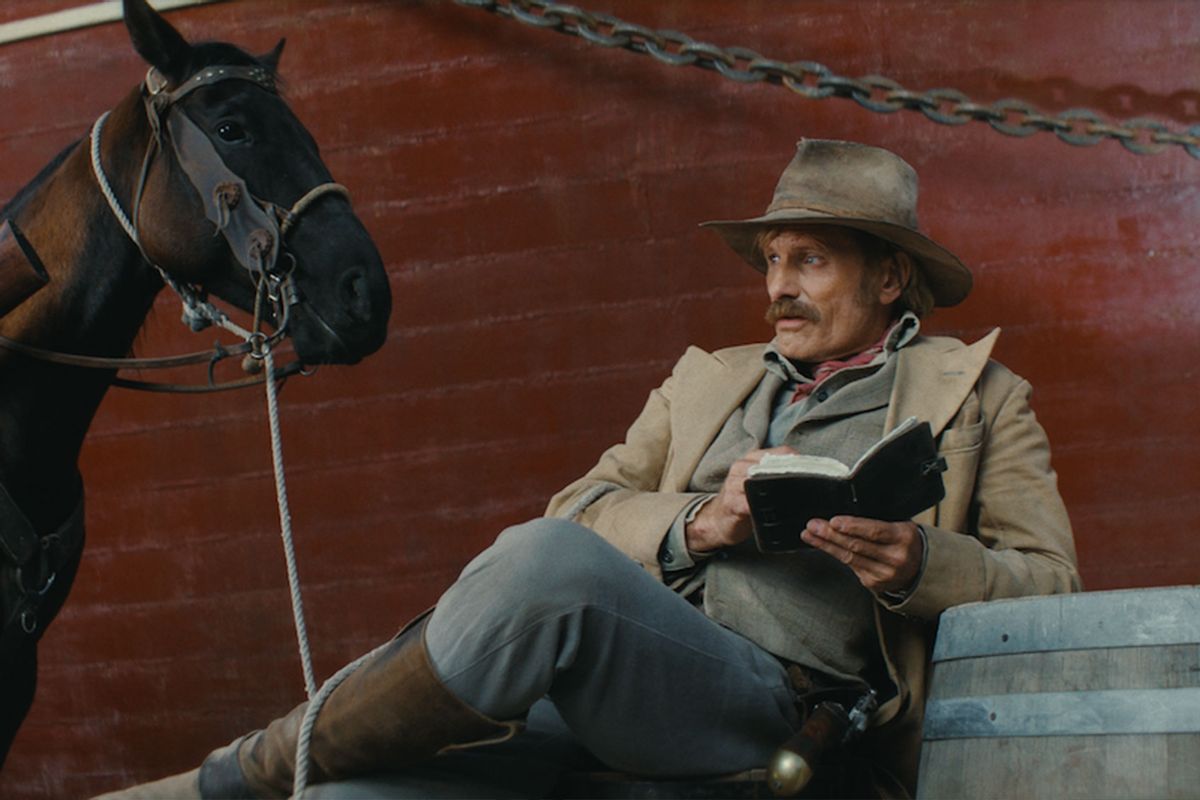Viggo Mortensen’s terrific sophomore effort as a writer/director (he also composed the music) is the gorgeous Western, “The Dead Don’t Hurt.”
Set during the Civil War, the film recounts the relationship between Vivienne Le Coudy (Vicky Krieps) and Holger Olsen (Mortensen), who meet and fall in love. When he goes off to fight the war, she stays behind. The film stays behind with her.
While “The Dead Don’t Hurt” has elements of a revenge thriller, this slow-burn drama takes its time and sits with the characters. Mortensen fixes his camera on Vivienne’s face to absorb her emotions after a particularly difficult moment, or on Holder when he returns home after years of fighting the war. As the film villain, Weston Jeffries’ (Solly McLeod) presence is felt in many scenes, but he has very limited screen time, a testament to Mortensen’s care in telling the story to focus less on the shootout and more on the characters — all of whom feel authentic.
Mortensen also pens a screenplay rich with language that features unexpected narrative details that inform the emotions that range from loss and injustice to greed, love and revenge.
Moreover, the actor-turned-filmmaker shoots his Western with a painterly eye. A courtroom scene is brilliantly lit, and the sweeping vistas are majestic. As a filmmaker, Mortensen uses space, like the town saloon, or a barn, where a deal is made, to contain the action.
As an actor, Mortensen delivers a low-key performance as Holger, whose romance with Vivienne is sweet. His interactions with the town Mayor (Danny Huston), are terse. And it is satisfying to watch Holger and Weston square off, especially in the film’s end.
“The Dead Don’t Hurt” is a perfect vehicle for Mortensen, who sent hearts swooning as the romantic lead in “A Walk on the Moon,” and appeared in some period Westerns, including “Appaloosa” and “Hidalgo.” He spoke with Salon about putting his spin on the classic genre.
You have a real investment in this film, writing, directing, acting, and composing. It is also much grander in scale than your previous effort as a filmmaker, “Falling,” which was an intimate family drama. What influenced you to make “The Dead Don’t Hurt?” Do you gravitate towards the Western genre?
"It is different to have woman be at the center of the story, to stay with her as the guy goes off to war."
I wanted to tell a story about Vivienne, who is very a woman of her time. I don’t think she is totally unique. I’m sure there were lots of women like her. There just hasn’t been — and isn’t still — much interest in making stories from that time with a woman as a central character. Their stories are untold, just like the stories of little girls and women whose sons or brothers or fathers or partners go off to war, as happens in this story. We don’t usually stay with them. What happens to them? What are the consequences? What goes through their minds? And what do they have to deal with? Normally, in a story like this, I guess you see the guy at war, and you might glimpse her now and then, so you don’t totally forget her. When the guy comes home, much later than you thought he would — which happens here — she is either dead or married someone else, and we think that’s too bad for him. Or she gives him a warm embrace, and welcomes him home joyfully and tearfully, and that’s great for her. I was asking myself, “What about her? What has she been up to and what are the consequences for her?” It’s not so easy for her after a long absence. I decided to place a woman like this in that historical time period because I thought it would present greater challenges for her, someone who is independent and strong-willed and stubborn. Society is lawless and dominated by powerful, unscrupulous men; that presents a greater challenge for her to be who she is. That’s how it became a Western. I do like Westerns, and once I realized this is going to be a Western, I make the most of it with my team to research it and get details right and respect certain codes of classic Westerns in terms of the visuals.
 Vicky Krieps in "The Dead Don't Hurt" (Marcel Zyskind/Shout! Studios)What did the research involve that allowed you to create such authenticity?
Vicky Krieps in "The Dead Don't Hurt" (Marcel Zyskind/Shout! Studios)What did the research involve that allowed you to create such authenticity?
We the whole team, including the actors, the costumers, art department and cinematography, looked at photos from that period — miners, cowboys, women, buildings towns, streets. I rewatched Westerns I’d seen as a kid, and watched many, many, many others. In the oldest of the Westerns, from the silent period, which was the beginning of the genre, they were fairly close to the historical period. You could see details in saddles and costumes, and the building were still extant. So, you could see things that look right for the period when you compare them to photos of the period. Early Westerns maybe weren’t great movies, but there were things to glean there and share with the team. I enjoyed doing all the research on the film.
How did you lean into or away from the tropes of the Western? There are many familiar elements — the saloon, the greed, the shootout — but they feel fresh.
As I said, it is different to have woman be at the center of the story, to stay with her as the guy goes off to war. It is also unusual to have the leads in a Western not be Anglo-Saxons and not have English as their first language [as Holger and Vivienne do]. To show different characters, like Claudio (Rafael Plana), the piano player, or with characters with Irish or different American accents.
I really appreciated the language in the film, such as a line, “That’s a huckleberry above my persimmon,” which I am going to start using immediately. [The phrase means, “Something better than something else.”]
Depending on the character, they use different slang or vocabulary. The way he speaks and presents himself, Mayor Schiller (Danny Huston) is probably the only person in the region who has been to college and has a law degree. He is very verbose and speaks in a certain way. Garret Dillahunt’s character, Alfred Jeffreys, is a man of few words, but he has some pretty interesting turns of phrase, like the one you mentioned. It was important to get those details right, and I enjoyed researching that. There are Westerns, even not so distant ones, like say, “The Missouri Breaks,” the way Harry Dean Stanton’s character speaks, he has some great turns of phrase that are accurate to the time period. W. Earl Brown, who plays Kendall, the salon owner, also has a particular way of speaking.
“The Dead Don’t Hurt” features shooting, a sexual assault and other scenes of violence. You don’t show them to be too bloody, but they feel visceral. Can you talk about the presentation and depiction of violence in the film? There is a line in which a character asks, “Why do men fight?”
"The film doesn’t exactly do that in the way you expect."
In her way, Vivienne fights too and stands up for herself. I think it’s more important to ask questions and have the audience make up their own mind. And it is important what you don’t show or don’t say in movies a lot of times. In beginning of story, you realize Holger and the boy aren’t just leaving town because there is no reason to stay anymore; the town leaders are corrupt and so forth. Once you realize he is trailing someone, then you think this is a revenge story, and vengeance is going to be the end result of this, and let’s see how we get there. But then the film doesn’t exactly do that in the way you expect. For me, in this story, I was clear that forgiveness — forgiving yourself for your imperfections — is much more important than vengeance.
 The Dead Don't Hurt (Marcel Zyskind/Shout! Studios)There is a morality to your film as well as to your character, Holger, who encounters some issues that other men might not handle with grace. You often play good guys who face bad situations. Can you discuss this aspect of your roles?
The Dead Don't Hurt (Marcel Zyskind/Shout! Studios)There is a morality to your film as well as to your character, Holger, who encounters some issues that other men might not handle with grace. You often play good guys who face bad situations. Can you discuss this aspect of your roles?
In this story, it was important when you talk about violence — whether sexual violence or violence with weapons, people shooting each other or someone getting beat up horribly in a saloon, which also happens — if you show every single thing, and do what many people do, use slow motion, and lots of inserts, and close-ups and show every aspect of a physical violation of someone else’s space or body. It’s often when you don’t show all of that, what you imagine is much more terrible. There is an art to that I’ve learned from lots of good directors, men and women, that I have worked with over the years. You try to focus on that. If you focus on the question, “Why do men fight?” or “Why does Holger go to war?” I think he has righteous, noble intentions, like many people do. He thinks it is the right thing to do or he feels he has to do it for moral reason. But any war, of any kind, no matter how righteous intentions are or motivations for going to war, it’s always a mistake. It’s always an error, and it always has disastrous consequences for those involved directly in the war and those who are related to that person. The end result is always sadness and destruction and tragedy and waste. I am not trying to tell people to think that, but I am showing.
Part of the forgiveness between Holger and Vivienne is that even though they are a man and a woman of their time with all the limitations that go with that, they are both open to considering what the other person feels and thinks; they are open to evolving. In any relationship where one or both of the parties are not open to adapting to new circumstances and how the other person changes, it's not going have a future. It is just going to wither on the vine. They are both stubborn and different, but they forgive each other and try to understand each other.
You have collaborated frequently with David Cronenberg, made a series of films in Argentina, are known for the “Lord of the Rings” trilogy and became a heartthrob when “A Walk on the Moon” was released. What observations do you have about your career at this stage, where you are shifting into working more behind the camera?
If I had the financing for one of the five scripts that I have now I’d start preproduction tomorrow. I have one I have shot to make, which is a smaller story. Hopefully that won’t be like “Falling,” which took four and a half years. This movie took two and a half years before I shot it. It depends on people liking the last film I made and taking a chance on it. The one I hope to make is an Argentine story. It’s a country used to adversity, and I think out of this period, with this government in place, I think there will be some really unusual risks taken, and people will tell some interesting stories as a result. It’s bound to happen. It will not be easy, but there will be some really good work coming out of there.
Want a daily wrap-up of all the news and commentary Salon has to offer? Subscribe to our morning newsletter, Crash Course.
The images in “The Dead Don’t Hurt” are gorgeous. I love that you held the camera on Vivienne after her attack and Holger when he returns home from the war. What can you say about creating the look of the film?
It depends on your actors, but the idea was to make a movie visually that was simple and elegant, the way Westerns were shot by people as different as Howard Hawks and Budd Boetticher. You try to not draw any attention to the way a camera looks at things and show landscapes in an artful way, the characters in this landscape with all the details in a way that makes the audience want to be there or imagining yourself there: “What I do in that situation?” Not, “How amazing is that shot?” Sergio Leone, other Westerns you are very conscious of the camerawork. And that’s fine too. It can be great. It’s just a different type of Western, that’s all. I wanted to make a Western as different as the story is from other Westerns. I wanted it to look and feel like an authentic, classic Western.
“The Dead Don’t Hurt” is currently in theaters nationwide.
Read more
interviews by Gary Kramer



Shares